苏珊和我最近回到西藏,我喜欢沉浸在它的历史、宗教和文化。最近征服中国和被现代化武力是应变整个古代社会的。一个可以因前往修道院在朝圣未经官方许可,甚至拥有自己的照片宗教领袖达赖喇嘛。成千上万的中国移民被鼓励每年在增长和现代化城市,一旦新铁路完成后,将会大量的细流。
通过旅行到更偏远的地区,人们仍然可以体验事物的已经为数百,甚至数千年,但即使在这里变化是缓慢的。看到牧民和牧民围捕和强行搬进了新建的城镇,他们的孩子去学校,不允许他们会说自己的语言或穿他们的传统服装,我想起了我们自己的土著人口和历史重演。
我的心被撕裂的,发生了什么,但是我发现很难是道德上优于中国因为我生活在陆地上,赢得了我的祖先在完全相同的方式,可能是真正的人类的每一个成员,无论他们住在哪里。当然古代藏族本身被征服者一千年前,被打败之前,撤退到他们的远程隔离,但过去的错误不能原谅现在的产品,希望有一天能够人类将进化到一个更高的水平。
彻底的美丽景观,人民和他们的文化是一个潜在的心理焦虑的在这个过渡时间,这就是我想要表达在这幅画。异国的美丽女孩的脸和她的环境,加上略微陷入困境的表情和姿势,完全反映我的情感反应西藏。
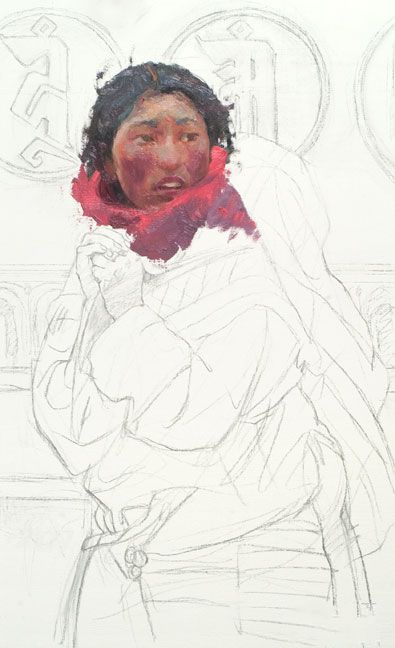
这个场景是复杂的,以至于我仔细和准确地画出来,木炭,使用头测量方法我早就在生活的图画课,不过简单的画我跳过绘图,然后右转进绘画。然后我开始阻塞在大形状的脸。
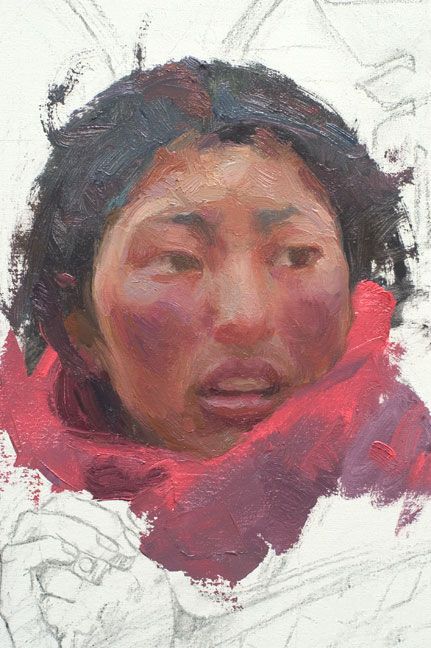

我继续工作更大的形状我的兴趣中心,脸,只要需要,直到我觉得我有正确的价值和色彩关系。不要匆忙的细节或者担心失去你的图纸。记住,绘图完成整个绘画与每个冲程你放下。我希望你注意到在这里你怎么总是从大到小的形状。看看我已经封锁了整个黑暗的形状在鼻子前先把小图形的鼻孔中最重要的是。我经常看到人们尝试相反把细节,然后试图漆周围其余的时间。
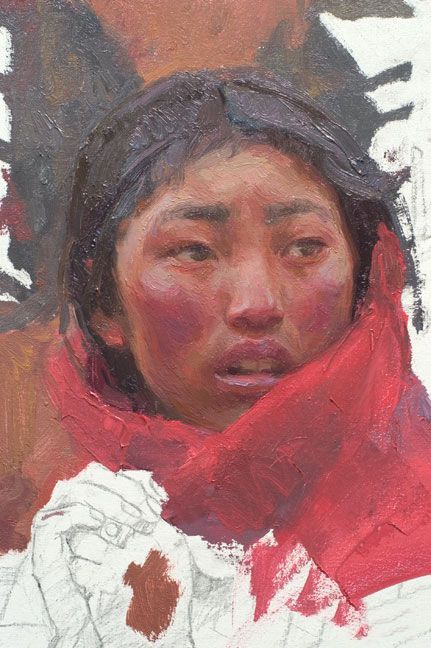
只有当我感到更大的形状是正确的我将在细节如高光和其他小的口音。注意鼻子已经看三维在前一个阶段——高光和暗的鼻孔只是配件到更大形式。
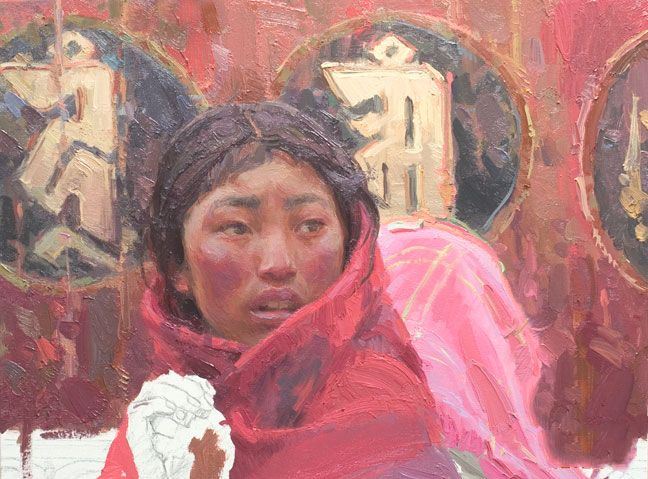
现在我搬到背景和形状围绕着脸。在现实中,女孩正站在人群中,但我选择了孤立她,使用一些黄金,西藏的符号在墙上画眼睛的脸和平衡光值的套筒。
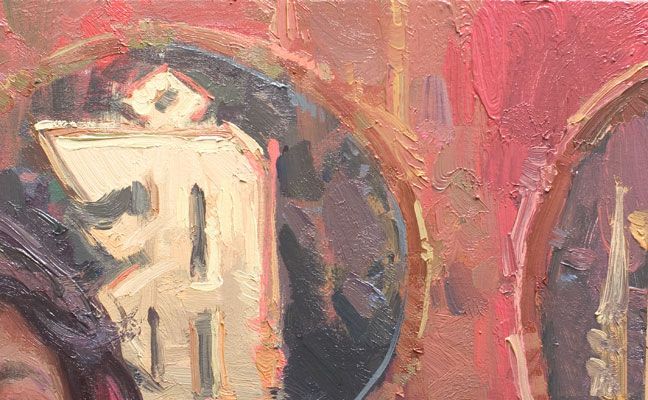
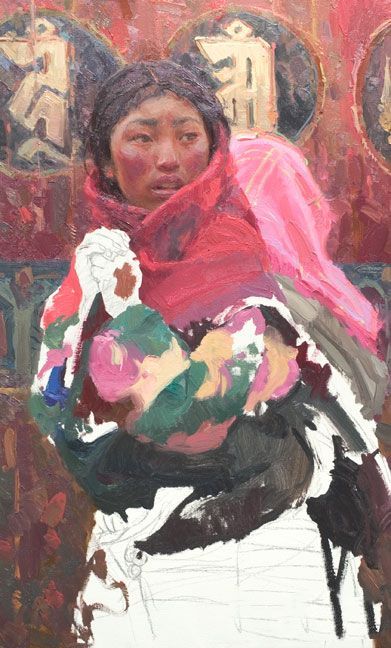
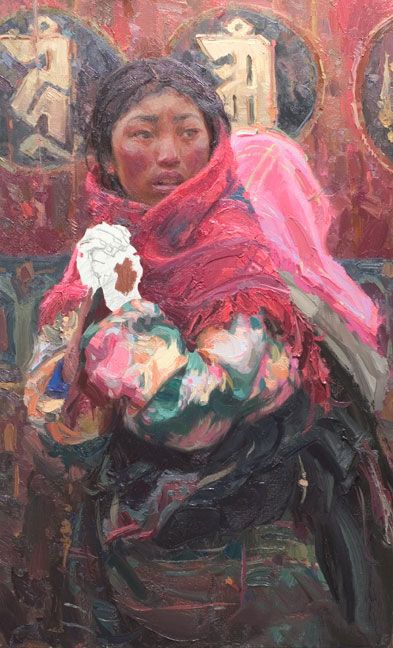
每一次我搬到一个新领域,我认为更大的形状介质的第一,然后,最后最小的形状。原因我不块在整个画布仅仅是在一个大的画我有困难地区的油漆干燥过早。
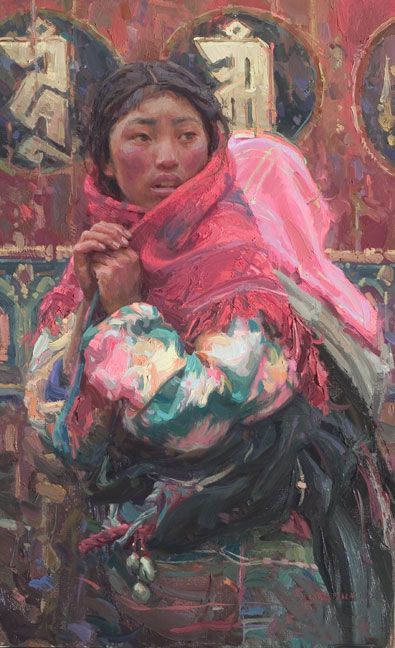
最终画
这只是末端的画,一切都是在一起的,这就是为什么它是如此重要,你的视觉设置放在脑中开始。有时我就盯着空白的画布上几个小时之前我能“看见”它显然不足以真正开始。
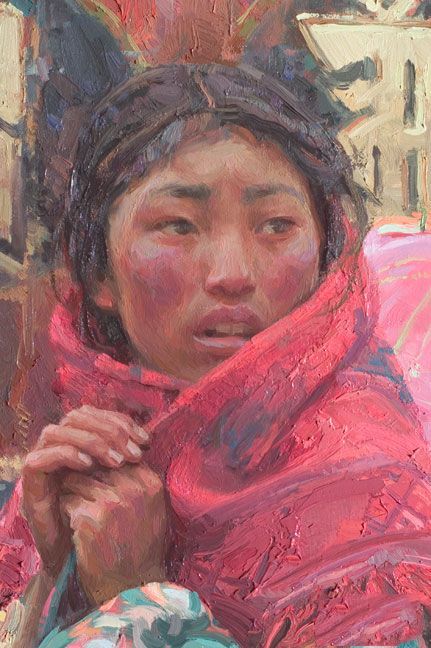
原文如下:
"A Pilgrim's Prayer" oil on stretched, Clausens double-primed oil linen. 36" by 22"
Susan and I recently returned from Tibet and I've loved immersing myself in its history, religion, and culture. Recently conquered by the Chinese and being modernized by force is straining the entire of their ancient society. One can be arrested for traveling to a monastery on pilgrimage without official permission, or even for possessing a photo of their religious leader, the Dalai Lama. Hundreds of thousands of Chinese settlers are encouraged each year to colonize the growing and modernizing cities and once the new railroad is finished, the trickle will become a flood.
By traveling to the more remote areas, one can still experience things as they've been for hundreds, if not thousands, of years, though even here change is creeping in. Seeing herders and nomads rounded up and forcibly moved into newly built towns, their children going to schools where they aren't allowed to speak their own language or wear their traditional clothes, I'm reminded of our own native population and how history repeats itself.
My heart is torn by what is happening, but I find it hard to be morally superior to the Chinese since I live on land that was won by my ancestors in the very same manner, as is probably true of every member of the human race, regardless of where they live. Certainly the ancient Tibetans themselves were conquerors a thousand years ago, before being defeated and retreating into their remote isolation, but past wrongs don't excuse present ones and hopefully someday humanity will evolve to a higher level.
The utter beauty of the landscape, the people, and their culture is tempered by an underlying psychological anxiety in this transitional time and that is what I wanted to convey in this painting. The exotic beauty of the girl's face and her surroundings, combined with the slightly troubled expression and pose, perfectly mirrored my emotional response to Tibet.
This scene is complex enough that I carefully and accurately draw it out with charcoal, using the head-measuring method I learned long ago in Life Drawing class, though for simpler paintings I skip the drawing and go right into painting. Then I begin blocking in the large shapes of the face.
I continue working the larger shapes of my center-of-interest, the face, for as long as it takes until I feel I've got the correct value and color relationships. Don't rush into the details or worry about losing your drawing. Remember that drawing is done throughout the painting with every stroke you put down. I want you to notice here how you always go from larger shapes to smaller. See how I've blocked in the entire dark shape under the nose before putting the smaller shapes of the nostrils on top of that. Too often I see people try the opposite by putting in the details and then trying to paint around them the rest of the time.
Only when I feel the larger shapes are correct do I put in details like the highlights and other small accents. Notice how the nose already looked three dimensional in the previous stage - the highlights and darks of the nostril are only accessories to the larger form.
Now I move onto the background and shapes surrounding the face. In reality the girl was standing in a crowd, but I chose to isolate her and use some gold, Tibetan symbols on a wall to draw the eye to the face and balance the light values of the sleeve.
Each time I move to a new area, I consider the larger shapes first, then the medium ones, and finally the smallest shapes. The reason I don't block in the entire canvas is simply that in a large painting I'd have difficulty with the paint drying in areas prematurely.
Final Painting
It's only at the very end of the painting that everything comes together, that's why it's so important to have your vision set clearly in your mind at the start. Sometimes I'll just stare at the blank canvas for hours before I can "see" it clearly enough to actually start.






